TOYOTA PRIUS PLUG-IN HYBRID 2021 Owners Manual
Manufacturer: TOYOTA, Model Year: 2021, Model line: PRIUS PLUG-IN HYBRID, Model: TOYOTA PRIUS PLUG-IN HYBRID 2021Pages: 816, PDF Size: 132.85 MB
Page 101 of 816
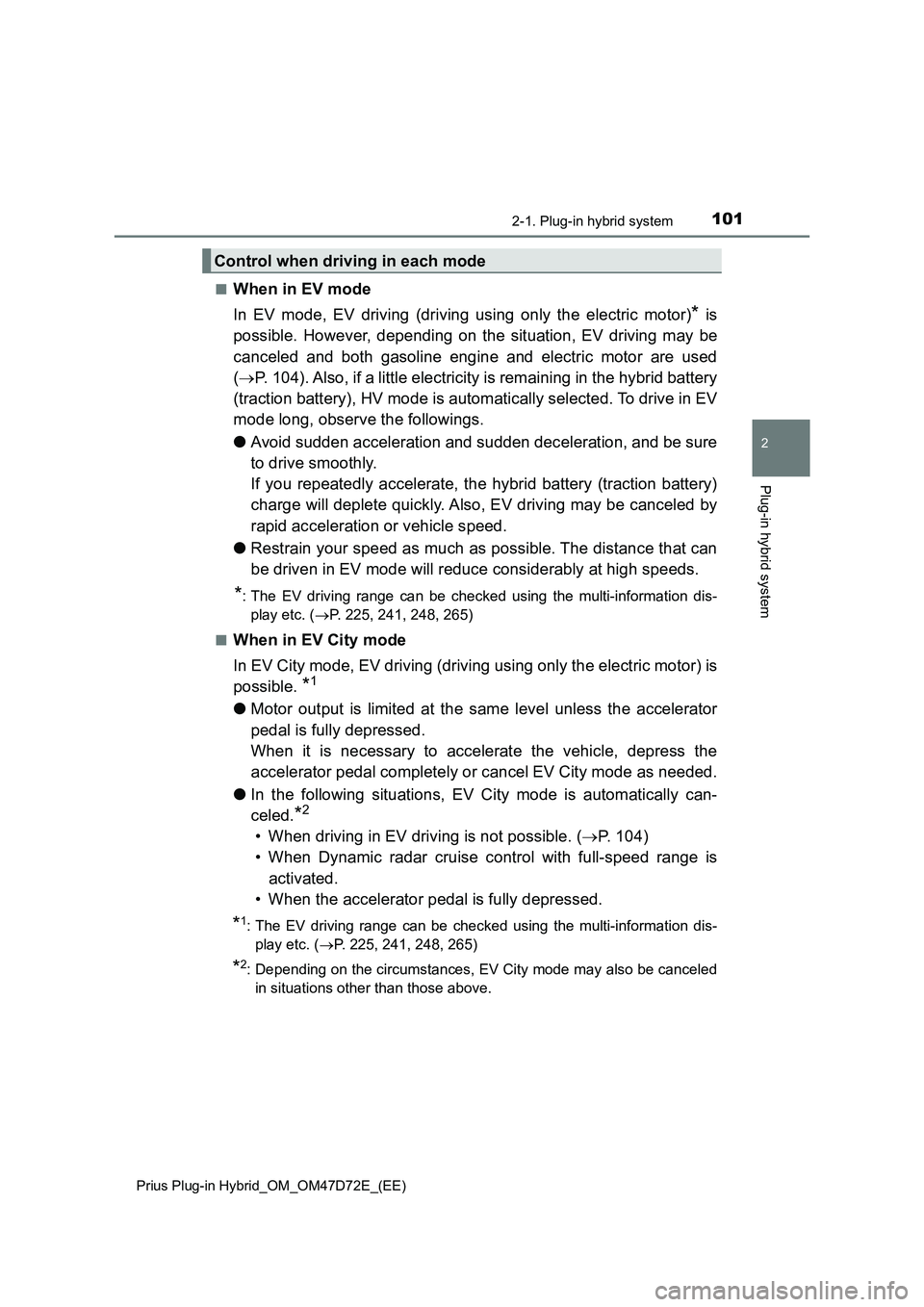
1012-1. Plug-in hybrid system
2
Plug-in hybrid system
Prius Plug-in Hybrid_OM_OM47D72E_(EE)
■When in EV mode
In EV mode, EV driving (driving using only the electric motor)
* is
possible. However, depending on the situation, EV driving may be
canceled and both gasoline engine and electric motor are used
(P. 104). Also, if a little electricity is remaining in the hybrid battery
(traction battery), HV mode is automatically selected. To drive in EV
mode long, observe the followings.
●Avoid sudden acceleration and sudden deceleration, and be sure
to drive smoothly.
If you repeatedly accelerate, the hybrid battery (traction battery)
charge will deplete quickly. Also, EV driving may be canceled by
rapid acceleration or vehicle speed.
●Restrain your speed as much as possible. The distance that can
be driven in EV mode will reduce considerably at high speeds.
*: The EV driving range can be checked using the multi-information dis-
play etc. (P. 225, 241, 248, 265)
■
When in EV City mode
In EV City mode, EV driving (driving using only the electric motor) is
possible.
*1
●Motor output is limited at the same level unless the accelerator
pedal is fully depressed.
When it is necessary to accelerate the vehicle, depress the
accelerator pedal completely or cancel EV City mode as needed.
●In the following situations, EV City mode is automatically can-
celed.
*2
• When driving in EV driving is not possible. (P. 104)
• When Dynamic radar cruise control with full-speed range is
activated.
• When the accelerator pedal is fully depressed.
*1: The EV driving range can be checked using the multi-information dis-
play etc. (P. 225, 241, 248, 265)
*2: Depending on the circumstances, EV City mode may also be canceled
in situations other than those above.
Control when driving in each mode
Page 102 of 816
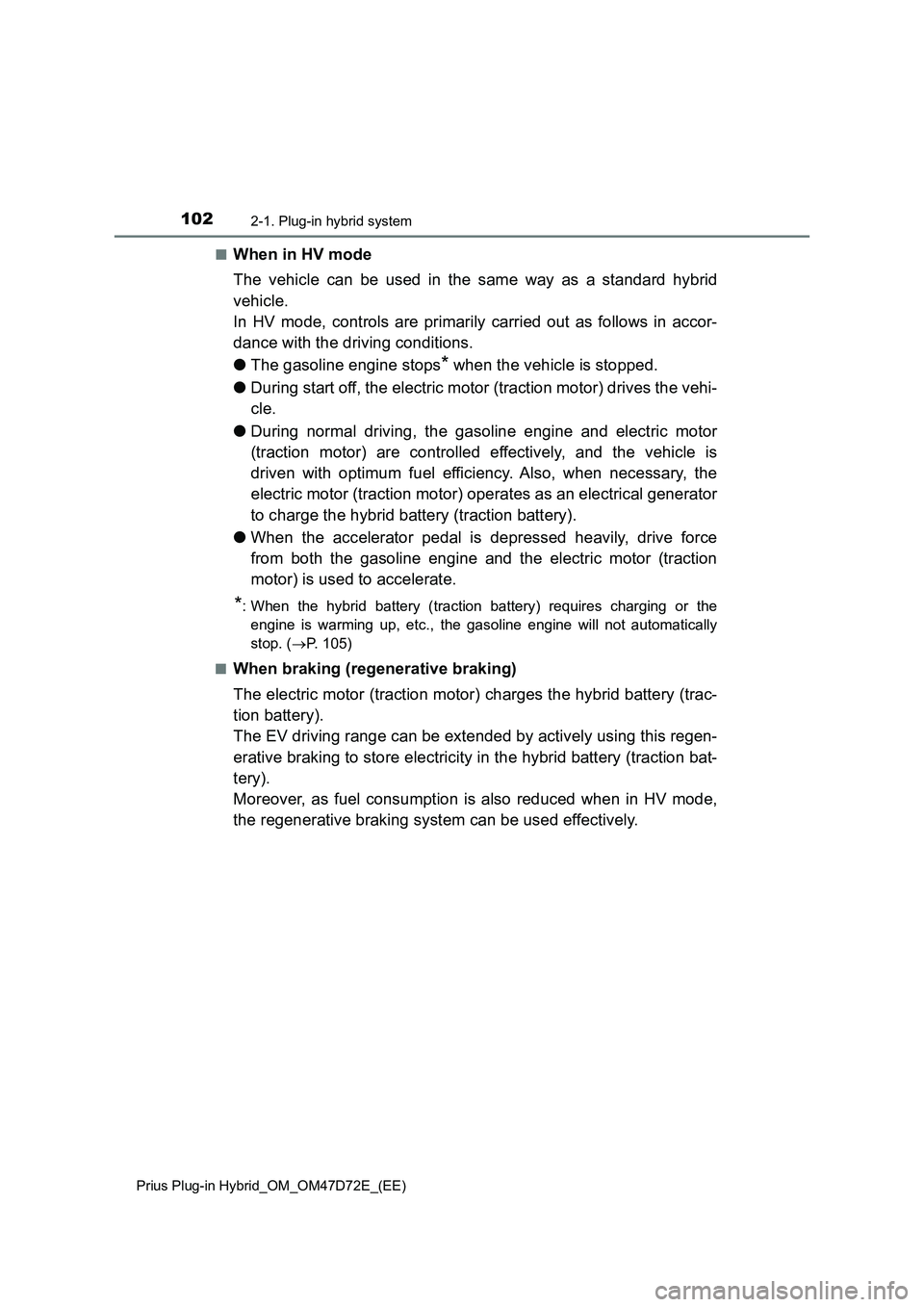
1022-1. Plug-in hybrid system
Prius Plug-in Hybrid_OM_OM47D72E_(EE)
■When in HV mode
The vehicle can be used in the same way as a standard hybrid
vehicle.
In HV mode, controls are primarily carried out as follows in accor-
dance with the driving conditions.
●The gasoline engine stops
* when the vehicle is stopped.
●During start off, the electric motor (traction motor) drives the vehi-
cle.
●During normal driving, the gasoline engine and electric motor
(traction motor) are controlled effectively, and the vehicle is
driven with optimum fuel efficiency. Also, when necessary, the
electric motor (traction motor) operates as an electrical generator
to charge the hybrid battery (traction battery).
●When the accelerator pedal is depressed heavily, drive force
from both the gasoline engine and the electric motor (traction
motor) is used to accelerate.
*: When the hybrid battery (traction battery) requires charging or the
engine is warming up, etc., the gasoline engine will not automatically
stop. (P. 105)
■
When braking (regenerative braking)
The electric motor (traction motor) charges the hybrid battery (trac-
tion battery).
The EV driving range can be extended by actively using this regen-
erative braking to store electricity in the hybrid battery (traction bat-
tery).
Moreover, as fuel consumption is also reduced when in HV mode,
the regenerative braking system can be used effectively.
Page 103 of 816
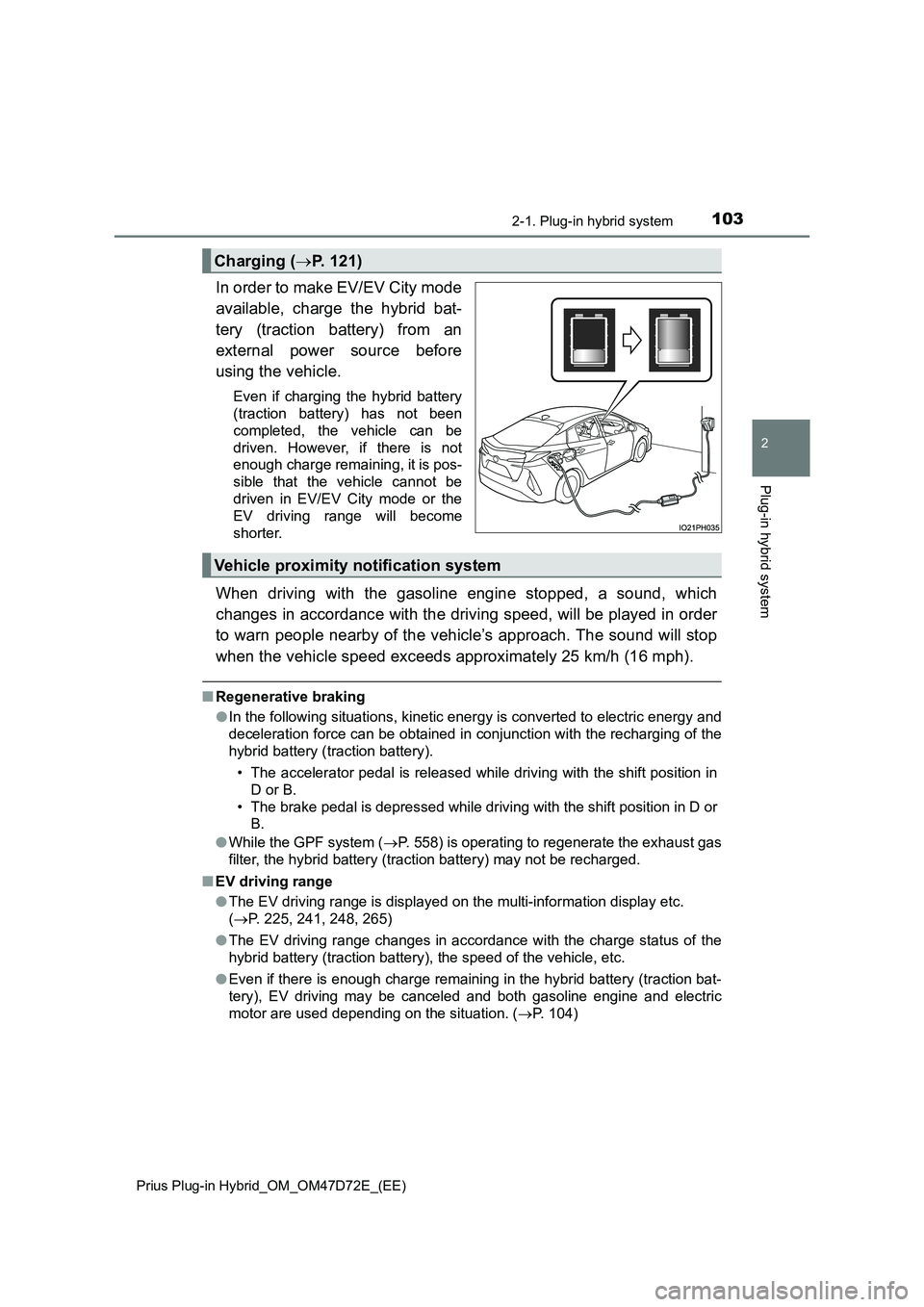
1032-1. Plug-in hybrid system
2
Plug-in hybrid system
Prius Plug-in Hybrid_OM_OM47D72E_(EE)
In order to make EV/EV City mode
available, charge the hybrid bat-
tery (traction battery) from an
external power source before
using the vehicle.
Even if charging the hybrid battery
(traction battery) has not been
completed, the vehicle can be
driven. However, if there is not
enough charge remaining, it is pos-
sible that the vehicle cannot be
driven in EV/EV City mode or the
EV driving range will become
shorter.
When driving with the gasoline engine stopped, a sound, which
changes in accordance with the driving speed, will be played in order
to warn people nearby of the vehicle’s approach. The sound will stop
when the vehicle speed exceeds approximately 25 km/h (16 mph).
■ Regenerative braking
● In the following situations, kinetic energy is converted to electric energy and
deceleration force can be obtained in c onjunction with the recharging of the
hybrid battery (traction battery).
• The accelerator pedal is released while driving with the shift position in
D or B.
• The brake pedal is depressed while driving with the shift position in D or
B.
● While the GPF system (P. 558) is operating to regenerate the exhaust gas
filter, the hybrid battery (traction battery) may not be recharged.
■ EV driving range
● The EV driving range is displayed on the multi-information display etc.
( P. 225, 241, 248, 265)
● The EV driving range changes in accordance with the charge status of the
hybrid battery (traction battery), the speed of the vehicle, etc.
● Even if there is enough charge remaining in the hybrid battery (traction bat-
tery), EV driving may be canceled and both gasoline engine and electric
motor are used depending on the situation. ( P. 104)
Charging (P. 121)
Vehicle proximity notification system
Page 104 of 816
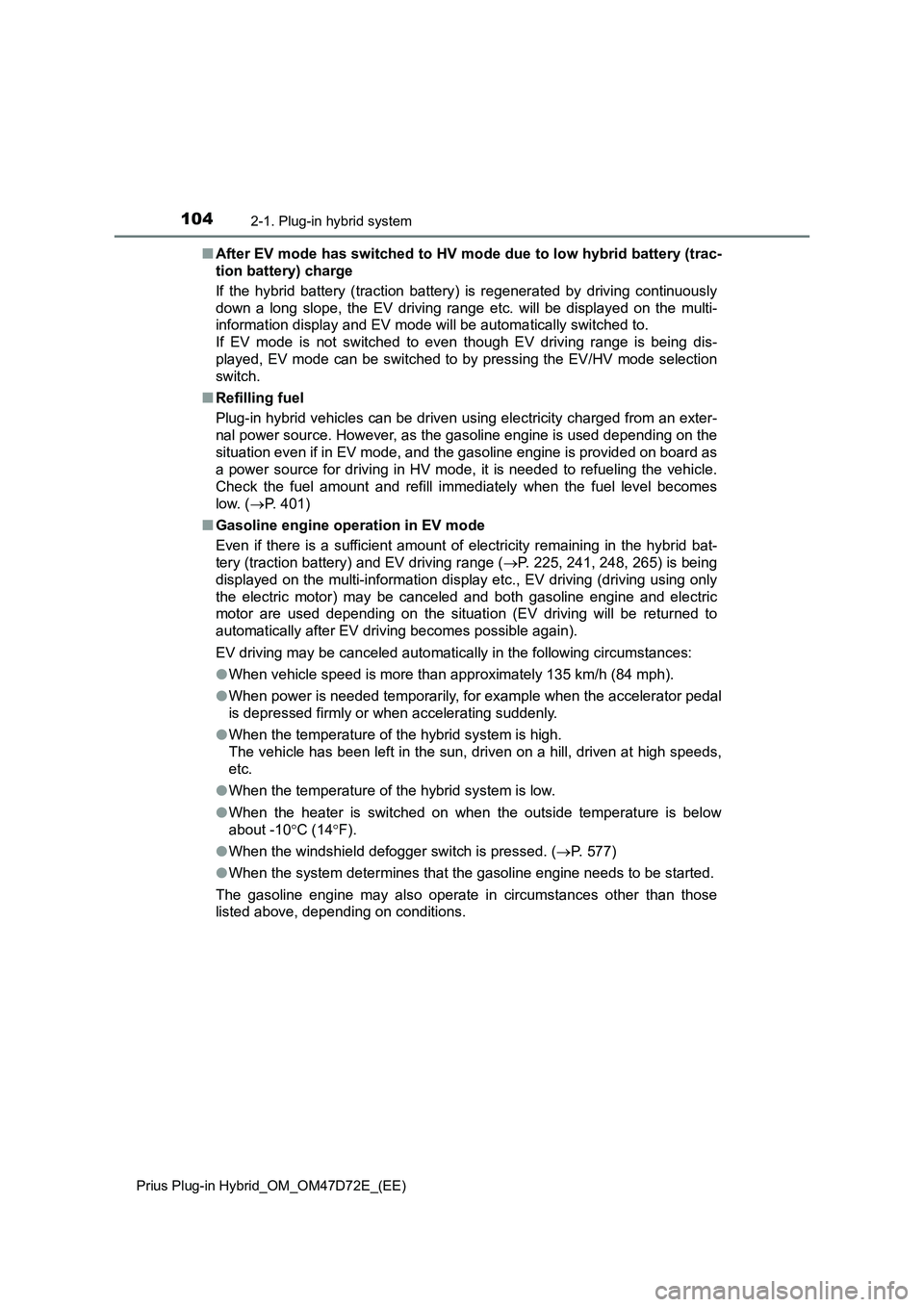
1042-1. Plug-in hybrid system
Prius Plug-in Hybrid_OM_OM47D72E_(EE)
■After EV mode has switched to HV mode due to low hybrid battery (trac-
tion battery) charge
If the hybrid battery (traction battery) is regenerated by driving continuously
down a long slope, the EV driving range etc. will be displayed on the multi-
information display and EV mode will be automatically switched to.
If EV mode is not switched to even though EV driving range is being dis-
played, EV mode can be switched to by pressing the EV/HV mode selection
switch.
■Refilling fuel
Plug-in hybrid vehicles can be driven using electricity charged from an exter-
nal power source. However, as the gasoline engine is used depending on the
situation even if in EV mode, and the gasoline engine is provided on board as
a power source for driving in HV mode, it is needed to refueling the vehicle.
Check the fuel amount and refill immediately when the fuel level becomes
low. (P. 401)
■Gasoline engine operation in EV mode
Even if there is a sufficient amount of electricity remaining in the hybrid bat-
tery (traction battery) and EV driving range (P. 225, 241, 248, 265) is being
displayed on the multi-information display etc., EV driving (driving using only
the electric motor) may be canceled and both gasoline engine and electric
motor are used depending on the situation (EV driving will be returned to
automatically after EV driving becomes possible again).
EV driving may be canceled automatically in the following circumstances:
●When vehicle speed is more than approximately 135 km/h (84 mph).
●When power is needed temporarily, for example when the accelerator pedal
is depressed firmly or when accelerating suddenly.
●When the temperature of the hybrid system is high.
The vehicle has been left in the sun, driven on a hill, driven at high speeds,
etc.
●When the temperature of the hybrid system is low.
●When the heater is switched on when the outside temperature is below
about -10C (14F).
●When the windshield defogger switch is pressed. (P. 577)
●When the system determines that the gasoline engine needs to be started.
The gasoline engine may also operate in circumstances other than those
listed above, depending on conditions.
Page 105 of 816
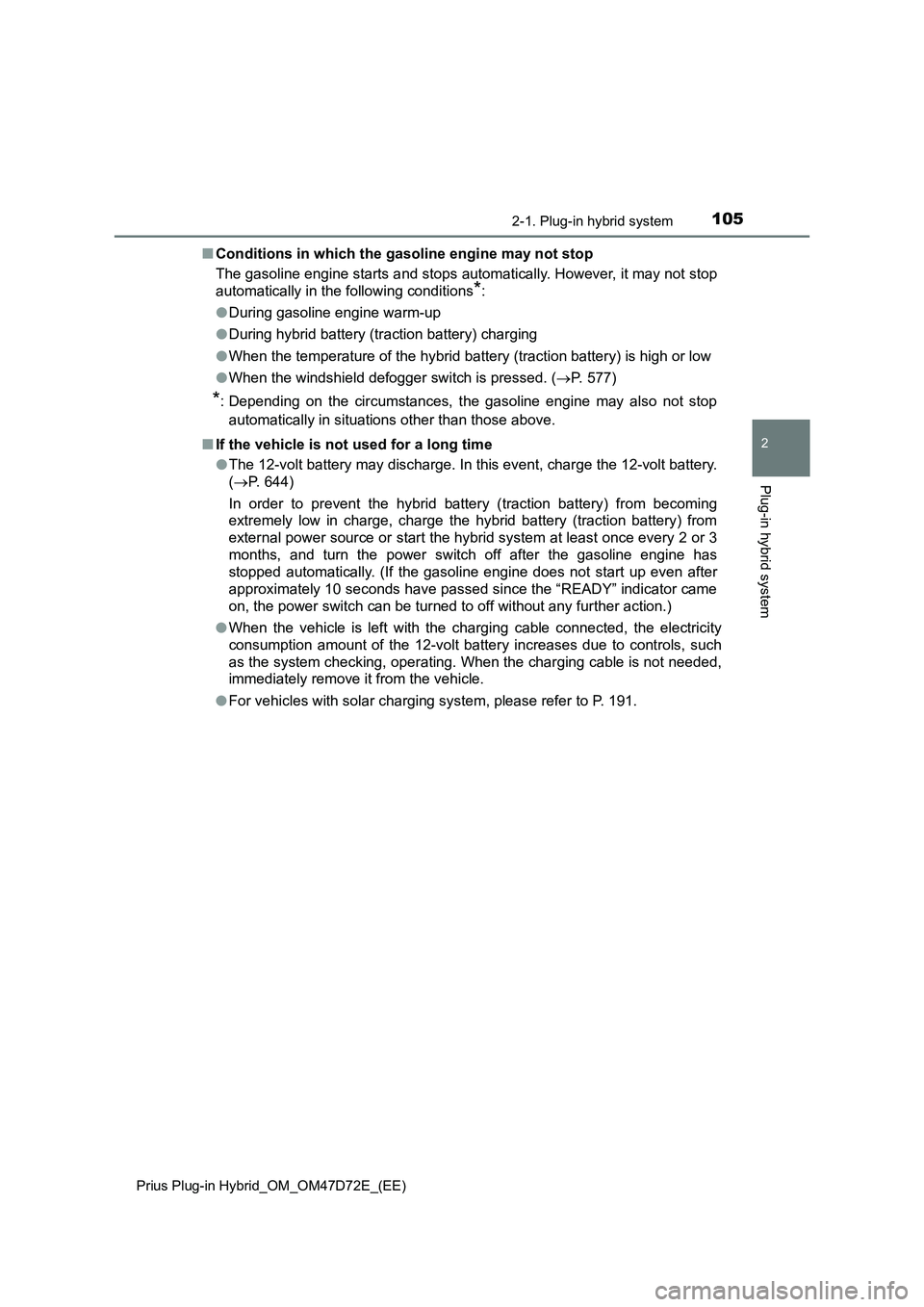
1052-1. Plug-in hybrid system
2
Plug-in hybrid system
Prius Plug-in Hybrid_OM_OM47D72E_(EE)
■Conditions in which the gasoline engine may not stop
The gasoline engine starts and stops automatically. However, it may not stop
automatically in the following conditions
*:
●During gasoline engine warm-up
●During hybrid battery (traction battery) charging
●When the temperature of the hybrid battery (traction battery) is high or low
●When the windshield defogger switch is pressed. (P. 577)
*: Depending on the circumstances, the gasoline engine may also not stop
automatically in situations other than those above.
■If the vehicle is not used for a long time
●The 12-volt battery may discharge. In this event, charge the 12-volt battery.
(P. 644)
In order to prevent the hybrid battery (traction battery) from becoming
extremely low in charge, charge the hybrid battery (traction battery) from
external power source or start the hybrid system at least once every 2 or 3
months, and turn the power switch off after the gasoline engine has
stopped automatically. (If the gasoline engine does not start up even after
approximately 10 seconds have passed since the “READY” indicator came
on, the power switch can be turned to off without any further action.)
●When the vehicle is left with the charging cable connected, the electricity
consumption amount of the 12-volt battery increases due to controls, such
as the system checking, operating. When the charging cable is not needed,
immediately remove it from the vehicle.
●For vehicles with solar charging system, please refer to P. 191.
Page 106 of 816
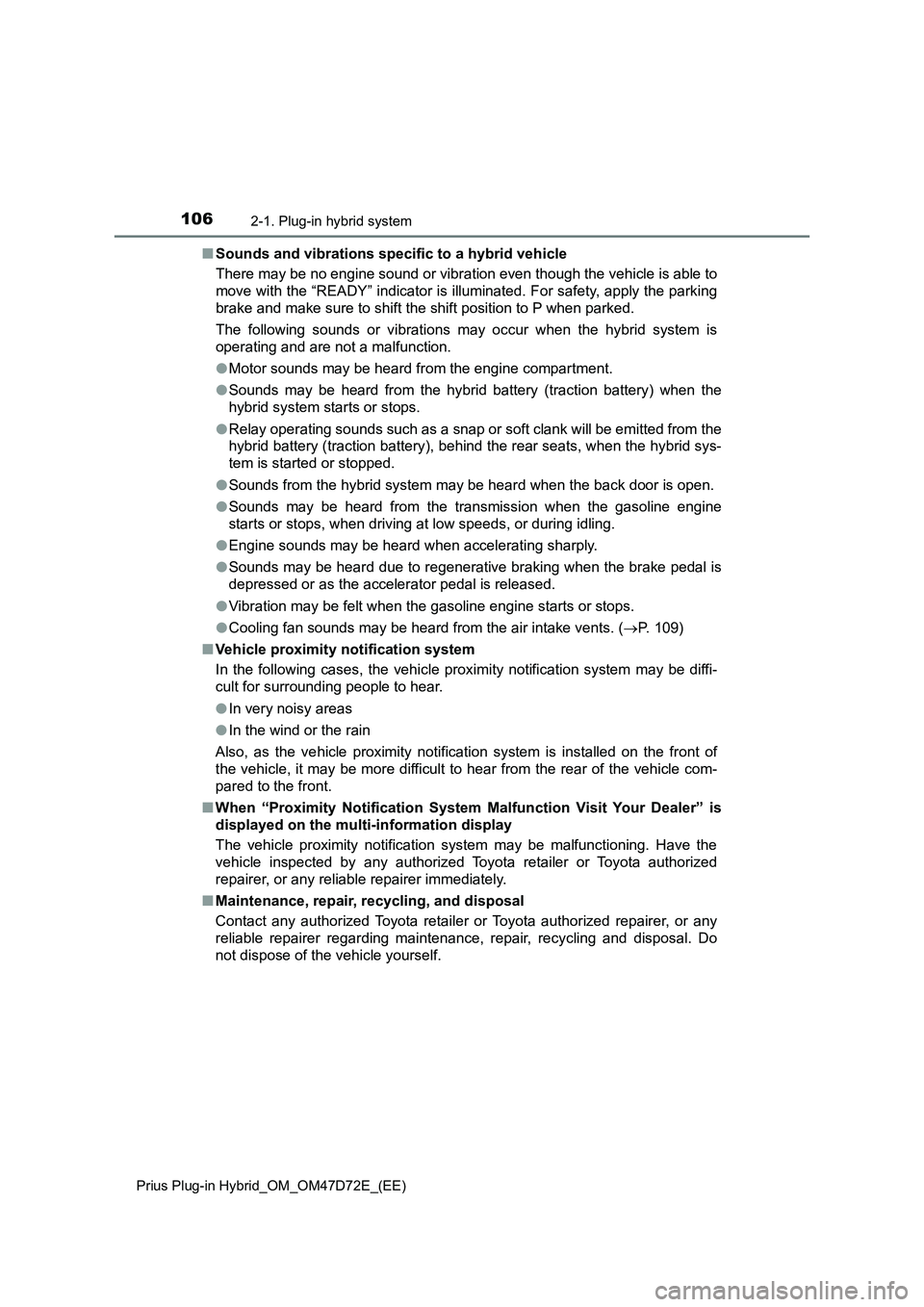
1062-1. Plug-in hybrid system
Prius Plug-in Hybrid_OM_OM47D72E_(EE)
■Sounds and vibrations specific to a hybrid vehicle
There may be no engine sound or vibration even though the vehicle is able to
move with the “READY” indicator is illuminated. For safety, apply the parking
brake and make sure to shift the shift position to P when parked.
The following sounds or vibrations may occur when the hybrid system is
operating and are not a malfunction.
●Motor sounds may be heard from the engine compartment.
●Sounds may be heard from the hybrid battery (traction battery) when the
hybrid system starts or stops.
●Relay operating sounds such as a snap or soft clank will be emitted from the
hybrid battery (traction battery), behind the rear seats, when the hybrid sys-
tem is started or stopped.
●Sounds from the hybrid system may be heard when the back door is open.
●Sounds may be heard from the transmission when the gasoline engine
starts or stops, when driving at low speeds, or during idling.
●Engine sounds may be heard when accelerating sharply.
●Sounds may be heard due to regenerative braking when the brake pedal is
depressed or as the accelerator pedal is released.
●Vibration may be felt when the gasoline engine starts or stops.
●Cooling fan sounds may be heard from the air intake vents. (P. 109)
■Vehicle proximity notification system
In the following cases, the vehicle proximity notification system may be diffi-
cult for surrounding people to hear.
●In very noisy areas
●In the wind or the rain
Also, as the vehicle proximity notification system is installed on the front of
the vehicle, it may be more difficult to hear from the rear of the vehicle com-
pared to the front.
■When “Proximity Notification System Malfunction Visit Your Dealer” is
displayed on the multi-information display
The vehicle proximity notification system may be malfunctioning. Have the
vehicle inspected by any authorized Toyota retailer or Toyota authorized
repairer, or any reliable repairer immediately.
■Maintenance, repair, recycling, and disposal
Contact any authorized Toyota retailer or Toyota authorized repairer, or any
reliable repairer regarding maintenance, repair, recycling and disposal. Do
not dispose of the vehicle yourself.
Page 107 of 816
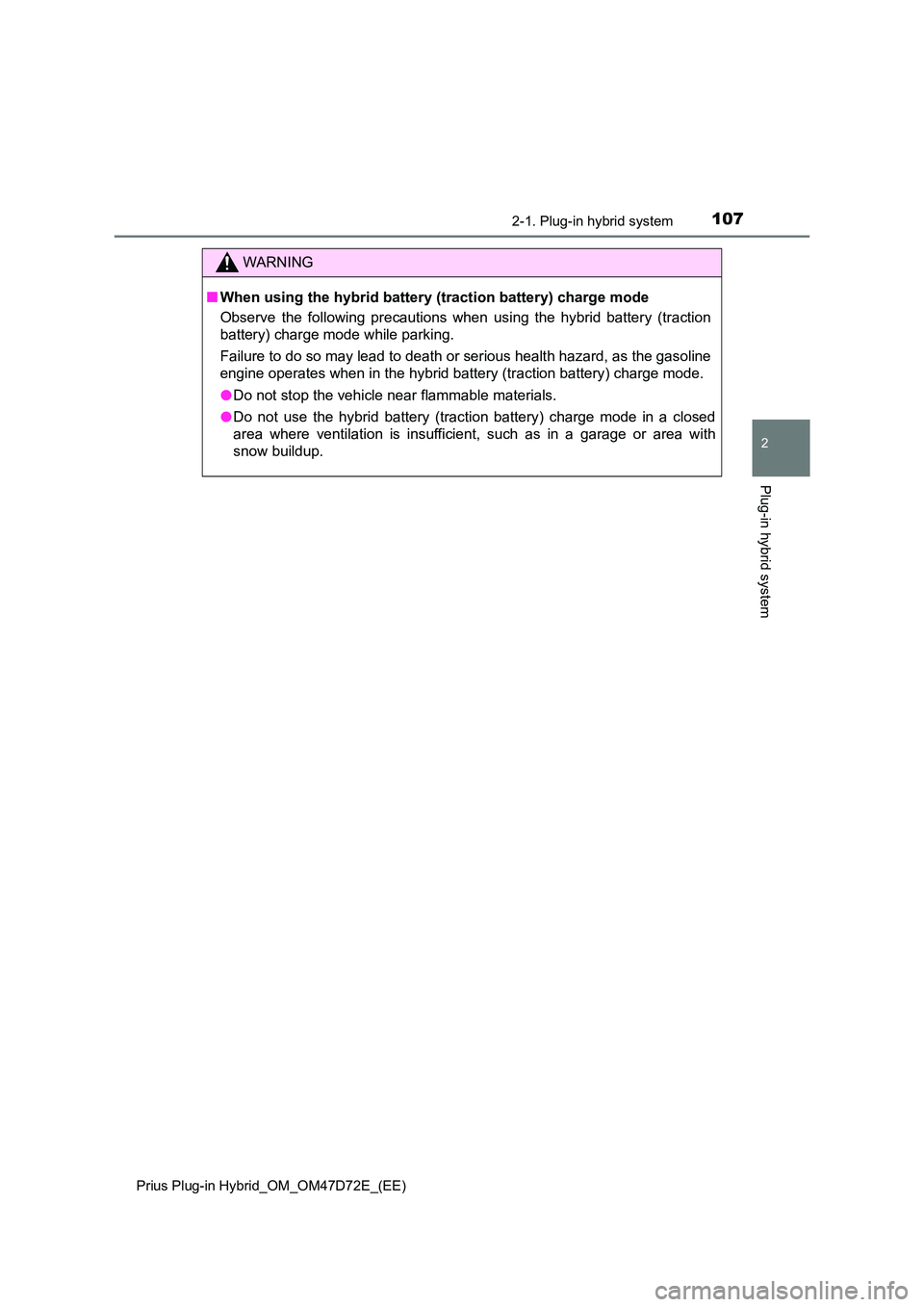
1072-1. Plug-in hybrid system
2
Plug-in hybrid system
Prius Plug-in Hybrid_OM_OM47D72E_(EE)
WARNING
■When using the hybrid battery (traction battery) charge mode
Observe the following precautions when using the hybrid battery (traction
battery) charge mode while parking.
Failure to do so may lead to death or serious health hazard, as the gasoline
engine operates when in the hybrid battery (traction battery) charge mode.
● Do not stop the vehicle near flammable materials.
● Do not use the hybrid battery (traction battery) charge mode in a closed
area where ventilation is insufficient, such as in a garage or area with
snow buildup.
Page 108 of 816
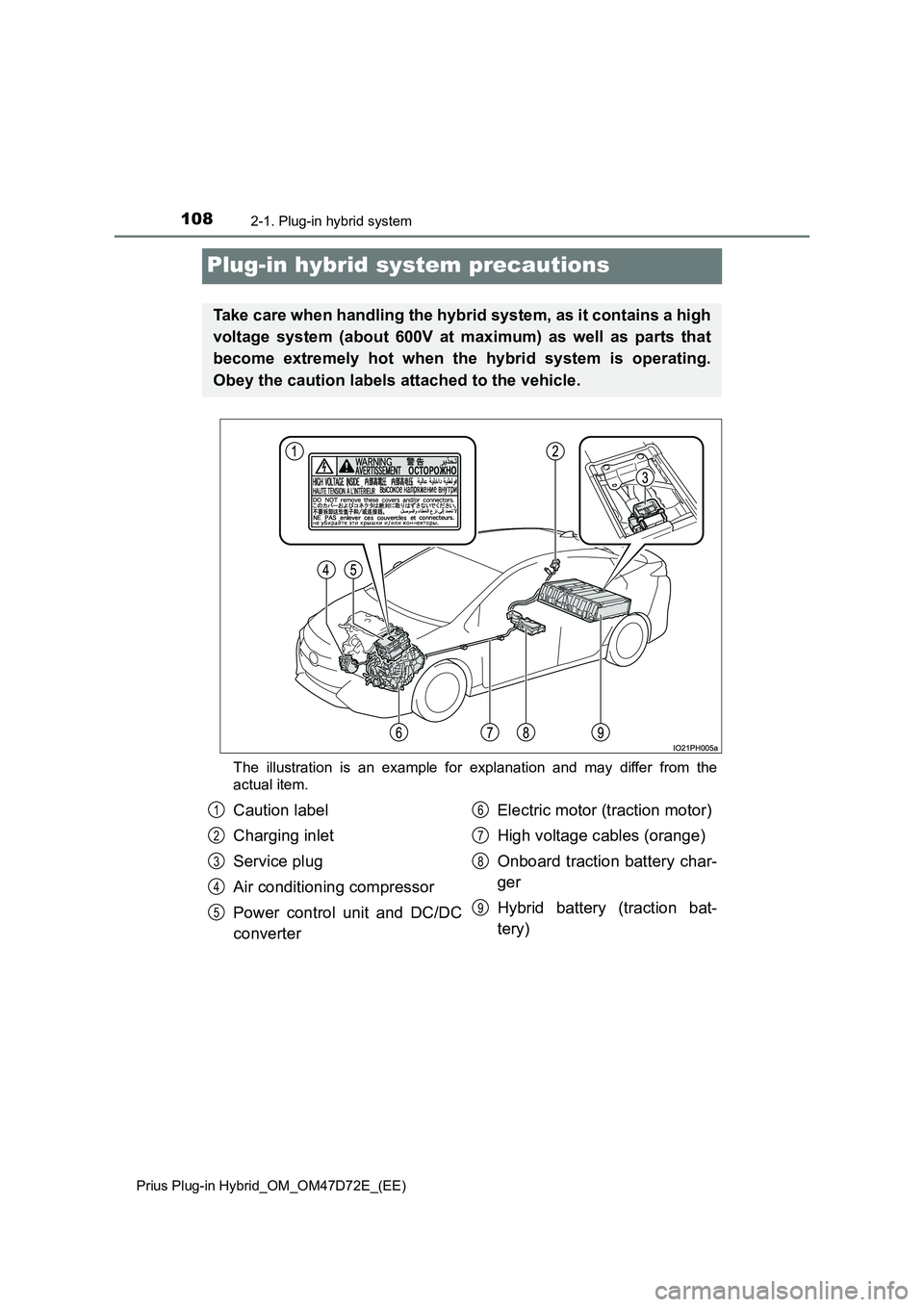
1082-1. Plug-in hybrid system
Prius Plug-in Hybrid_OM_OM47D72E_(EE)
Plug-in hybrid system precautions
The illustration is an example for explanation and may differ from the
actual item.
Take care when handling the hybrid system, as it contains a high
voltage system (about 600V at maximum) as well as parts that
become extremely hot when the hybrid system is operating.
Obey the caution labels attached to the vehicle.
Caution label
Charging inlet
Service plug
Air conditioning compressor
Power control unit and DC/DC
converterElectric motor (traction motor)
High voltage cables (orange)
Onboard traction battery char-
ger
Hybrid battery (traction bat-
tery)1
2
3
4
5
6
7
8
9
Page 109 of 816
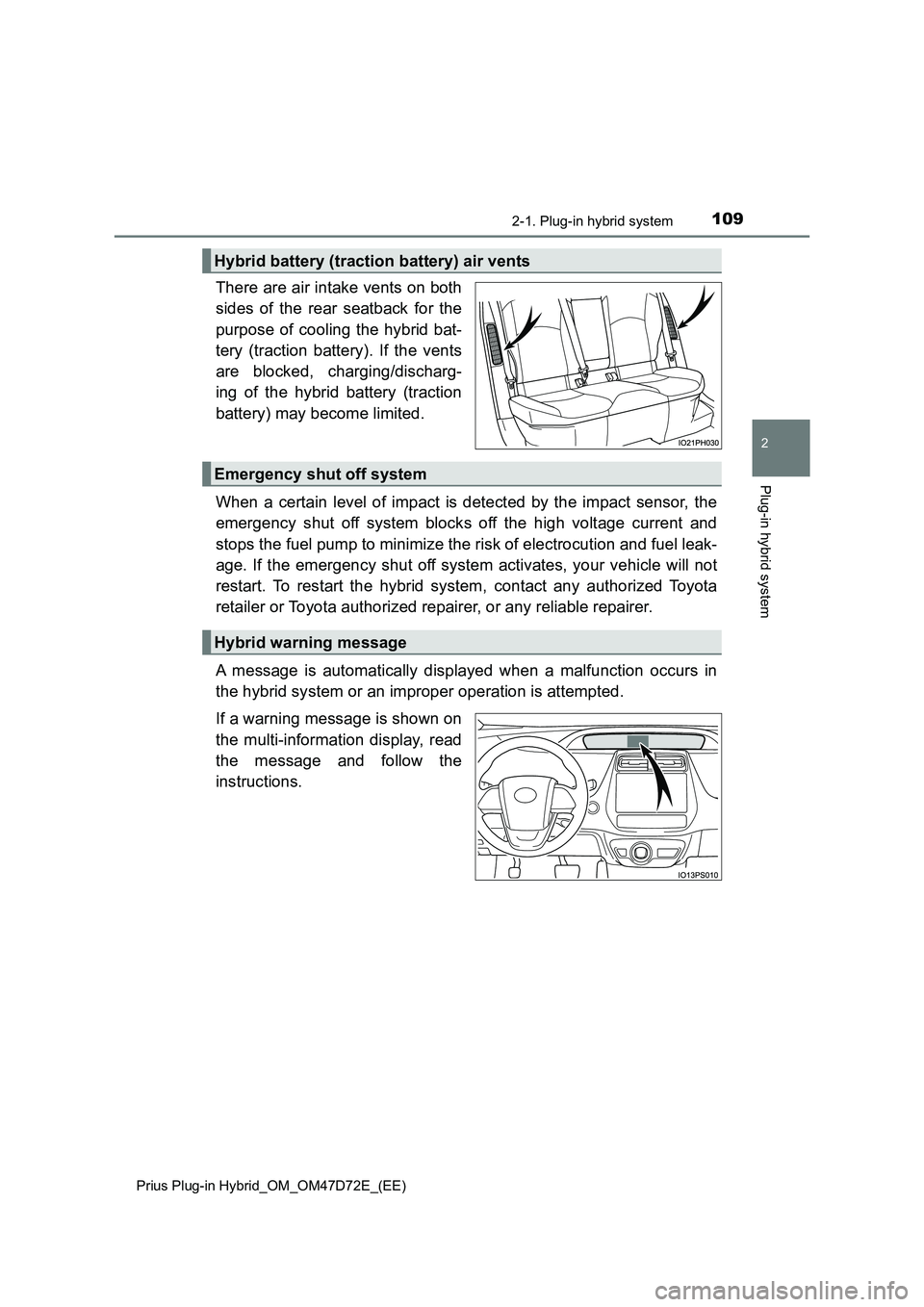
1092-1. Plug-in hybrid system
2
Plug-in hybrid system
Prius Plug-in Hybrid_OM_OM47D72E_(EE)
There are air intake vents on both
sides of the rear seatback for the
purpose of cooling the hybrid bat-
tery (traction battery). If the vents
are blocked, charging/discharg-
ing of the hybrid battery (traction
battery) may become limited.
When a certain level of impact is detected by the impact sensor, the
emergency shut off system blocks off the high voltage current and
stops the fuel pump to minimize the risk of electrocution and fuel leak-
age. If the emergency shut off system activates, your vehicle will not
restart. To restart the hybrid system, contact any authorized Toyota
retailer or Toyota authorized repairer, or any reliable repairer.
A message is automatically displayed when a malfunction occurs in
the hybrid system or an improper operation is attempted.
If a warning message is shown on
the multi-information display, read
the message and follow the
instructions.
Hybrid battery (traction battery) air vents
Emergency shut off system
Hybrid warning message
Page 110 of 816
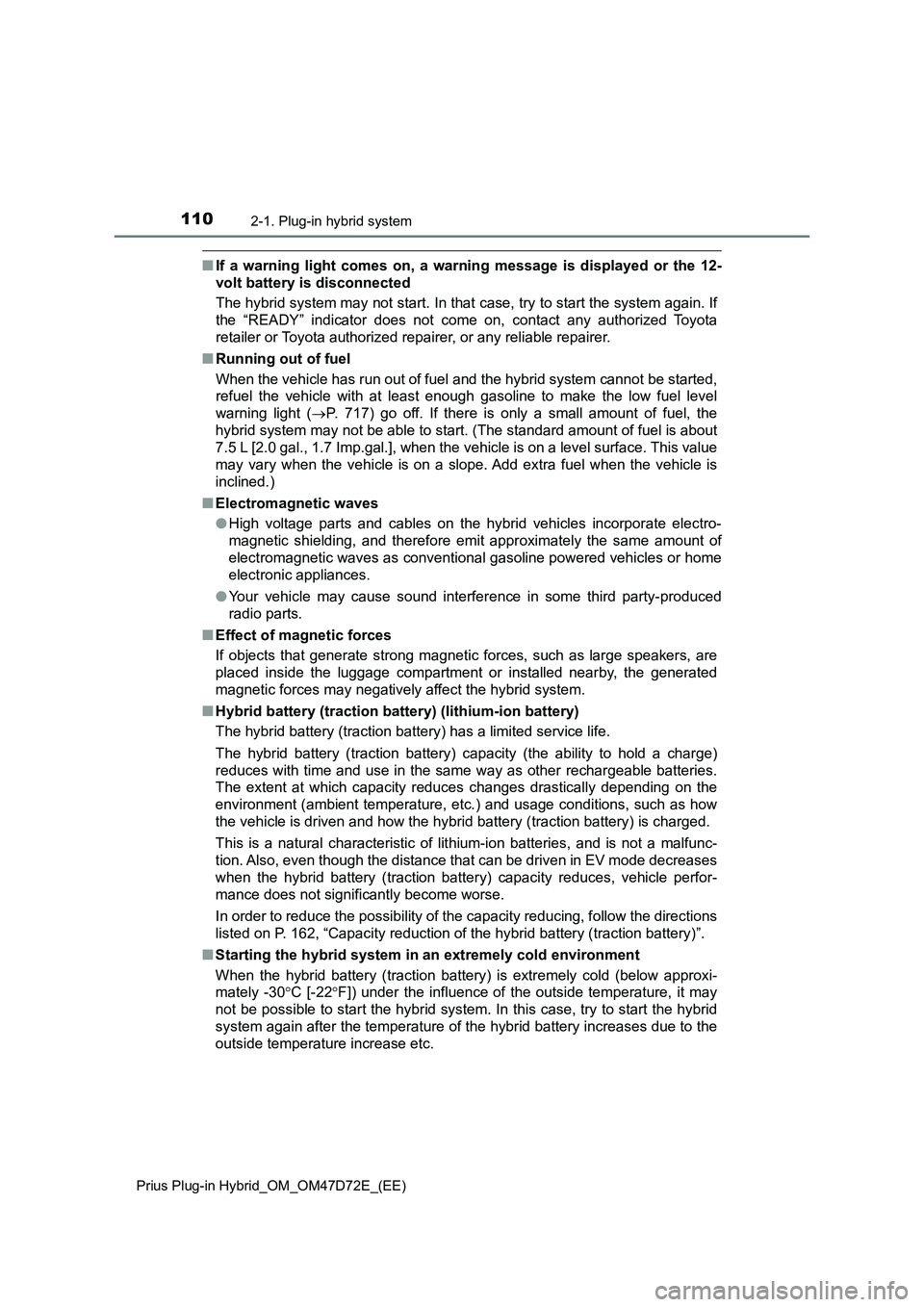
1102-1. Plug-in hybrid system
Prius Plug-in Hybrid_OM_OM47D72E_(EE)
■If a warning light comes on, a warning message is displayed or the 12-
volt battery is disconnected
The hybrid system may not start. In that case, try to start the system again. If
the “READY” indicator does not come on, contact any authorized Toyota
retailer or Toyota authorized repairer, or any reliable repairer.
■Running out of fuel
When the vehicle has run out of fuel and the hybrid system cannot be started,
refuel the vehicle with at least enough gasoline to make the low fuel level
warning light (P. 717) go off. If there is only a small amount of fuel, the
hybrid system may not be able to start. (The standard amount of fuel is about
7.5 L [2.0 gal., 1.7 Imp.gal.], when the vehicle is on a level surface. This value
may vary when the vehicle is on a slope. Add extra fuel when the vehicle is
inclined.)
■Electromagnetic waves
●High voltage parts and cables on the hybrid vehicles incorporate electro-
magnetic shielding, and therefore emit approximately the same amount of
electromagnetic waves as conventional gasoline powered vehicles or home
electronic appliances.
●Your vehicle may cause sound interference in some third party-produced
radio parts.
■Effect of magnetic forces
If objects that generate strong magnetic forces, such as large speakers, are
placed inside the luggage compartment or installed nearby, the generated
magnetic forces may negatively affect the hybrid system.
■Hybrid battery (traction battery) (lithium-ion battery)
The hybrid battery (traction battery) has a limited service life.
The hybrid battery (traction battery) capacity (the ability to hold a charge)
reduces with time and use in the same way as other rechargeable batteries.
The extent at which capacity reduces changes drastically depending on the
environment (ambient temperature, etc.) and usage conditions, such as how
the vehicle is driven and how the hybrid battery (traction battery) is charged.
This is a natural characteristic of lithium-ion batteries, and is not a malfunc-
tion. Also, even though the distance that can be driven in EV mode decreases
when the hybrid battery (traction battery) capacity reduces, vehicle perfor-
mance does not significantly become worse.
In order to reduce the possibility of the capacity reducing, follow the directions
listed on P. 162, “Capacity reduction of the hybrid battery (traction battery)”.
■Starting the hybrid system in an extremely cold environment
When the hybrid battery (traction battery) is extremely cold (below approxi-
mately -30C [-22F]) under the influence of the outside temperature, it may
not be possible to start the hybrid system. In this case, try to start the hybrid
system again after the temperature of the hybrid battery increases due to the
outside temperature increase etc.